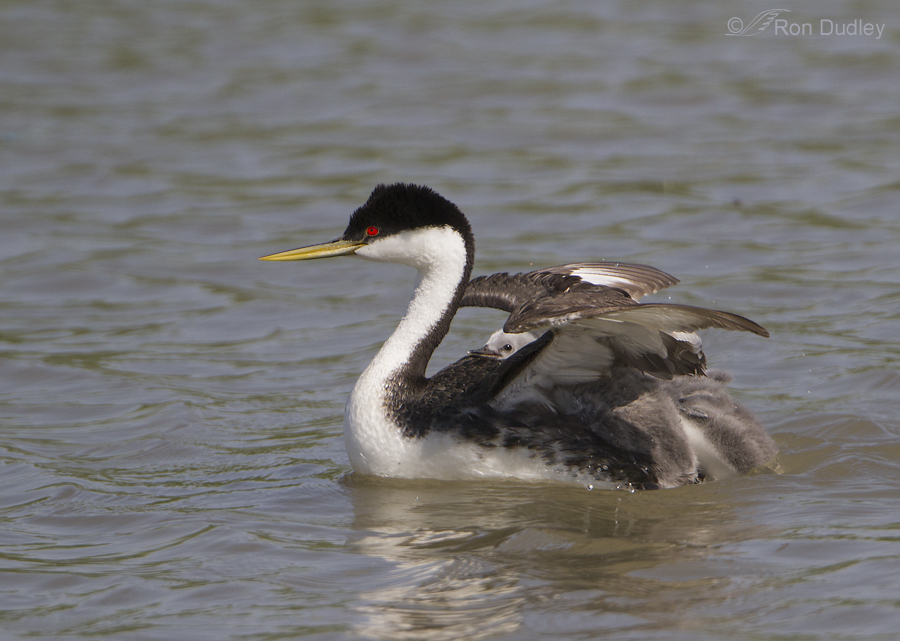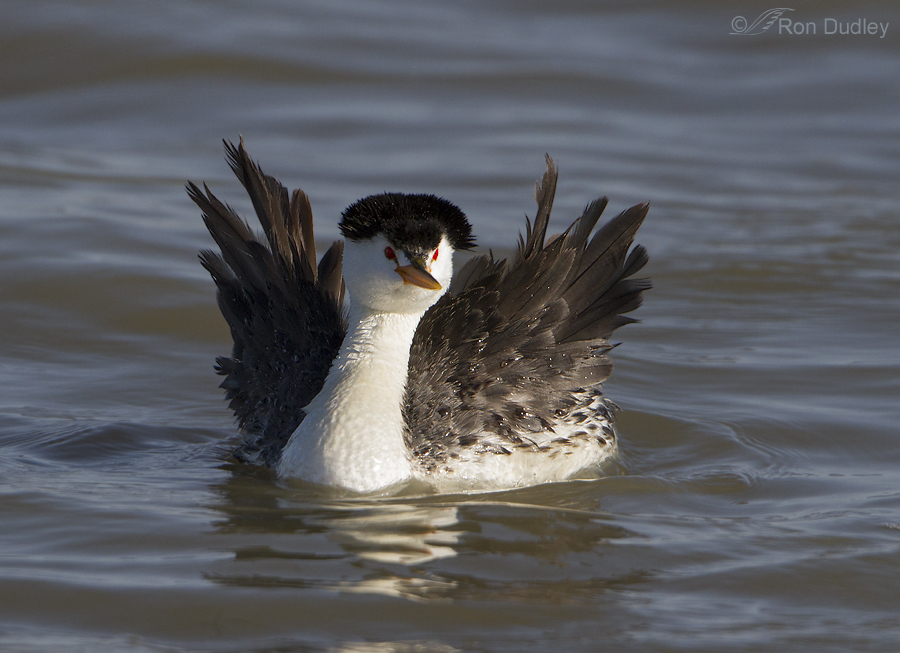Tag: bear river migratory bird refuge
Western Grebe – Dumping The Chick Load

At this age Western Grebe chicks are heavy-bodied, small headed, loud, awkward and demanding. They alternately ride on the back of each parent (back brooding) as the other adult rests or hunts for fish to feed to its family. At this stage the youngsters are good swimmers and there’s often not enough room on the parents back for all of the chicks to ride comfortably anyway so the parent uses an interesting strategy to “dump its load” into the water when it needs a break.
Juvenile Burrowing Owls Watching For “Incoming”
Pied-billed Grebe On Nest

Yesterday morning I was very surprised to see this active nest so close to the loop road at Bear River Migratory Bird Refuge. Both parents incubate and the sexes are similar so I don’t know if this was the male or the female but the apparent mate of this bird was hanging around in the general vicinity.
Mating Black-necked Stilts

On a recent trip to Bear River Bird Refuge we were photographing American Avocets when I noticed some tell-tale preliminary behavior from a pair of Black-necked Stilts that told me that mating was imminent. So I set up on them and quickly changed my settings for more depth of field and almost immediately the action began.
Clark’s Grebe Blowin’ In The Wind

Three days ago at Bear River Migratory Bird refuge I had some wind to contend with as I was photographing this Clark’s Grebe. It made the water a little choppy and would occasionally ruffle the feathers of one of the birds when it turned its back to the breeze.
The effect varied fairly dramatically.
Eastern Kingbird Casting A Pellet
Mating Rituals Of The American Avocet
The moment I pulled up on this small pond at Bear River Migratory Bird Refuge last Friday I knew there’d be some opportunities for interesting behavioral shots. There were small groups of American Avocets and Black-necked Stilts that were excitedly chirping away and flying at each other in typical springtime behavior for these mixed flocks.
Amorous Avocets
Having witnessed the rituals of avocets mating many times before I knew what was about to happen when this female laid her bill down on the water’s surface and presented herself to the male. This time I got the shot. So often in the past they’ve had their backs to me when it happened.
American Bittern In Habitat
The American Bittern may be the most elusive avian subject I’ve ever photographed. They’re solitary, cryptically colored and their preferred habitat is wetlands with tall, emergent vegetation. And they’re extremely secretive by nature. So much so that very little is known about their biology, which is too bad because perhaps if we understood them better we could more effectively manage their seriously declining populations.
Barn Swallow
I’ve always had a “thing” for Barn Swallows. I’m sure it goes back to my childhood on the family farm in Montana where they nested in huge numbers on and in all of the many old barns, granaries and outbuildings. As a kid I spent many hours watching their graceful flight with their long forked tail and pointed wings being quite distinctive. Another thing (besides the fond memories) that I’m indebted to them for is that the species indirectly led to the beginning of the conservation movement in the United States. The destruction of Barn Swallows for the millinery trade (those long tail feathers were apparently considered very attractive on the hat of a lady) during the 1800’s led to George Bird Grinnell’s article in Forest and Stream in 1886 that prompted the founding of the first Audubon Society. Hooray for Barn Swallows ! I think the way they’ve adapted to man is fascinating. They’re now the most abundant and widely distributed swallow in the world and originally they nested almost exclusively in caves but with the advent of human structures that has changed dramatically. They have almost completely converted to nesting in or on man-made structures like bridges, culverts and the eaves of buildings. In fact, in modern times any Barn Swallows found nesting on natural sites create quite a stir among birders and are often reported with much interest. 1/640, f/8, ISO 500, 500 f/4, 1.4 tc, natural light But I must admit that I also enjoy them in natural settings. I found this bird at Bear River MBR where…
Sandhill Crane Take-off Sequence
On a beautiful spring morning in May of 2011 we found a small group of Sandhill Cranes on a pond as we approached Bear River Migratory Bird Refuge. We were some of the first folks on the access road and our careful approach made two of the birds a little nervous so they decided to vacate the area. I believe they were a mated pair. I got my pickup stopped and my lens aimed just after the first bird began to take off. 1/2500, f/6.3, ISO 500, 500 f/4, 1.4 tc I believe this to be the slightly larger male who took off first. The unconventional composition is meant to highlight the water splashes behind the bird. If you’ve never heard the distinctive, penetrating and very loud bugling calls (also called “trumpeting”) of this species you’re really missing something. As is typical of these cranes, these two were calling during lift off and just looking at these images has that haunting sound bouncing around in my head. These cranes have an unusual throat anatomy that allows them to make such resonating sounds. The trachea extends and coils down the long neck and well into the sternum. This unique anatomy “expands the amplitude and alters the pitch of the voice by the addition of harmonies”. Until these birds are 9-10 months old they can produce only a series of trilled whistles and peeps but as they mature their tracheas elongate and coil intrasternally which allows them to develop the adult voice. If you’re curious about their call, check out both the “unison call” and…
Terns – After The Dive
Terns tend to be graceful and highly maneuverable flyers and those skills are very much on display when they’re fishing. 1/5000, f/6.3, ISO 500, 500 f/4, 1.4 tc, natural light I found this Forster’s Tern fishing at Bear River MBR last June and decided I’d attempt to photograph it coming out of the water after a dive – easier said than done. And to catch it with a fish would be a bonus. This species is known for feeding on “small” fish but this one is ridiculous – hardly worth the bother. If you look very carefully you can see the miniscule fish behind the upper part of the bill. I’ve cropped this shot unconventionally in order to include the “splash” behind the bird. These birds fish relentlessly. Their quarry is small, as is their success rate. In one Forster’s Tern study, 1538 dives produced 369 fish for a success rate of 24%. 1/5000, f/6.3, ISO 500, 500 f/4, 1.4 tc, natural light The fish is more easily seen in this next shot. When they come off the surface they usually shake excess water out of their feathers in mid-air. I caught this tern just before the shake, where it has twisted its wings in order to get good action for the upcoming shake. I missed the shake with this bird but… 1/1250, f/6.3, ISO 500, 500 f/4, 1.4 tc, natural light I did manage to capture it on another day with this Caspian Tern. I didn’t have enough shutter speed to get the quick movements particularly sharp but…
Western Grebe Fish Delivery
Temperatures are finally warming a bit here in northern Utah but the world is outside is still monotonously white. Yesterday morning I measured 22 1/2″ of snow on the north end of Antelope Island, indicating that our bleak and largely featureless landscape will remain the same for the foreseeable future. So this morning I needed a break and decided to post an image (taken this past June at Bear River MBR) that would remind me that spring is somewhere out there on the distant horizon. 1/3200, f/7.1, ISO 640, 500 f/4, 1.4 tc, natural light Western Grebes are devoted parents to their incessantly hungry and noisy chicks. The male and female take turns with their parental duties – one will back brood the youngsters while the other delivers fish and then they alternate responsibilities. Here the female (smaller than the male, with a shorter, thinner bill – thus sexual dimorphism) has caught a small fish and is delivering it to the male. Usually the parent receiving the fish will give it to the chick, as happened here. As I’m sure is obvious, I’m very much looking forward to watching and photographing springtime bird activities once again. It’s going to be a very long 2-3 months… Ron
Red Fox Kits At Play
Ok, here it is only the middle of January and I’ve already had my fill of frigid temperatures, snow and inversions. This post is my temporary escape from it all – to spring green, warm temperatures and cute animal babies. In May of 2010 I found a den of Red Fox Kits at Bear River Migratory Bird Refuge. The den was only about 15′ from the road edge and I never left my pickup or the road while photographing the youngsters. Some of the images here (there are lots of them) have technical issues of composition and light angle but hey, rambunctious fox kits are a challenge to photograph. At least that’s my excuse… The photography was frenetic. I used three different cameras and lenses (500mm with and without tc, 100-400 zoom and 17-85 zoom). I missed a lot of interesting shots while switching gear – fun and frustrating at the same time. I’m leaving out camera exif data this time – just too much work and I don’t have the time this morning. Sorry Dwynn… At first there was a single kit out of the den. Then there were two. Three. And finally, four – you can see the top of the head of the fourth one as it emerges from the den. This is the only shot I kept that included all four kits. These youngsters aren’t as red as one might expect because they were covered in gray dust from playing in the dirt and crawling through the den. I…




